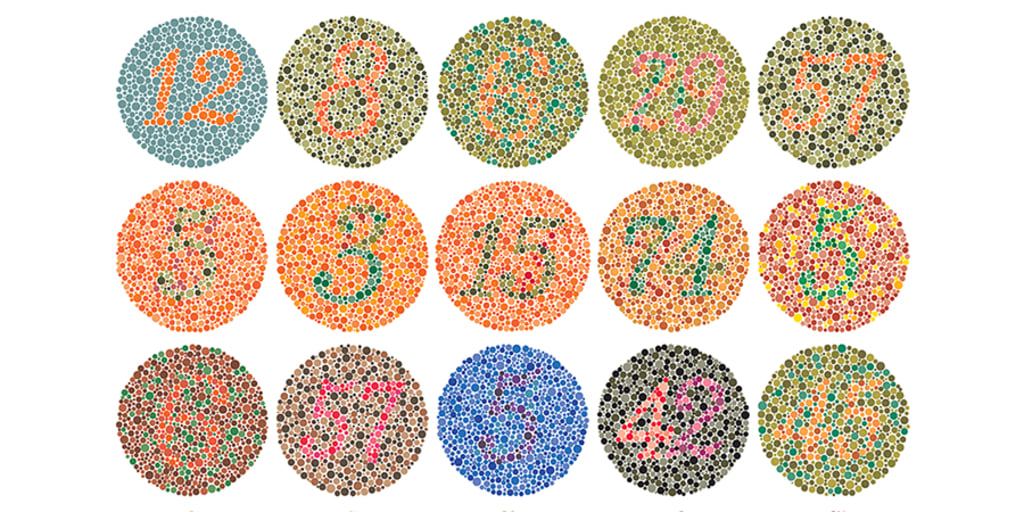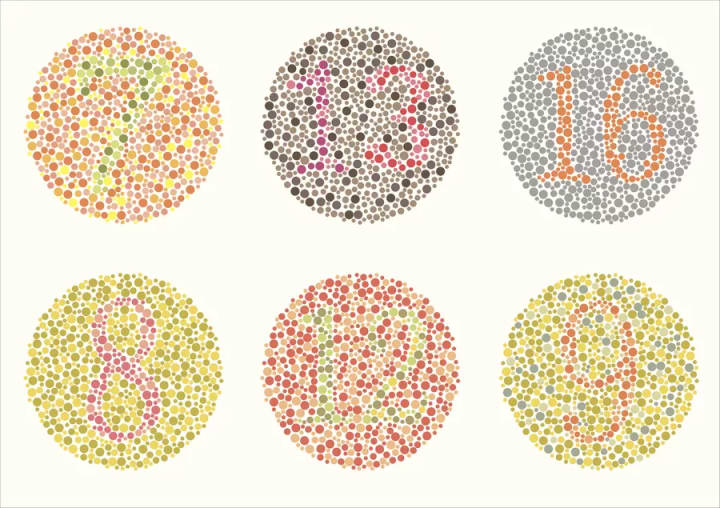What Is a Red-Green Color Blind Test?
Detects red-green color blindness

A red-green color blind test detects red-green color blindness, with the most common one being the Ishihara test. Red-green color blindness makes it difficult for someone to differentiate between red, green, and yellow.
Some people with red-green color blindness may not be aware of their condition. A red-green color blind test can let these people know that they have this form of color blindness, so they can take the necessary precautions to stay safe even when they can't tell some colors apart.
Red-Green Color Blindness
Red-green color blindness, also called red-green vision defects, is the most common type of color blindness, affecting about one in 12 males and 1 in 200 females among populations with North European ancestry. Reds and greens look similar to each other as a kind of brownish, muted tone to people with this form of color blindness.
There are four types of red-green color blindness:2
- Deuteranomaly: This is the most common red-green color blindness. It makes green appear more red. This type of red-green color blindness covers everything from almost normal vision to deuteranopia
- Deuteranopia: A stronger type of color blindness where someone cannot tell the difference between green and red at all
- Protanomaly: Red appears more green and less bright
- Protanopia: This is when the affected person cannot tell the difference between red and green at all
What Causes Color Blindness?
Color blindness, also known as color vision deficiency, is usually genetic, and is passed on from parents to children. In the retina, light receptor cells called rods and cones transmit signals from the eye to the brain. Rods provide vision in low light, while cones provide vision in bright light and color vision.
There are three types of cone cells, blue, green, and red, and each contains a specific pigment (called an opsin) that is sensitive to different wavelengths of light. How they overlap is how they create different colors.
Red-green color blindness is caused by genetic changes involving the OPN1LW or OPN1MW gene, which lead to an absence of certain cones or abnormal opsin pigments in the cones that affect red-green color vision.
Some cases of color blindness are acquired. They can arise from diseases involving the retina or areas of the brain involved in processing visual information, as side effects of certain drugs, or from exposure to particular chemicals.
Visual Tests
Ishihara Test
The Ishihara test is the most widely used test for red-green color blindness, and was created by Dr. Shinobu Ishihara almost 100 years ago. It consists of a set of 38 colored dotted plates (called Ishihara plates) that either contain a number or path-shaped design.
There are four types of plates:
- Vanishing design: People with good color vision will be able to see the design, but people with colorblindness will not.
- Transformation design: People with colorblindness will see a different design than people with good color vision
- Hidden digit design: People with color blindness will be able to see the number on the plate, and people with good color vision will not
- Classification design: This is used to determine red-and-green color blindness. The vanishing design is used on either side of the plate, one side for deutan defects and the other for protans
The Ishihara test works for most people. Other tests may be needed in some cases, however, such as for people whose eyesight is so poor they can’t see any of the image well, regardless of color. The military also uses more specialized testing.
Cambridge Color Test
Combining the principles of the Ishihara test plus new technologies, the Cambridge Color Test uses plates with colored dots like the Ishihara test, but uses a C-shape in a different color than the background. The C-shape, called the target, appears randomly in one of four orientations, and
the person taking the test must click on one of four keys to indicate the orientation.
At first, the target includes vivid, bright colors, which help establish the test taker’s reliability in determining the orientation of the C shown. Then, the computer alters the color quality (chromacity) between the target and background according to the person’s performance. There are longer and shorter versions of this test.
Another version of the Cambridge test used for people with low vision has four plates, but instead of the plates showing dots and a target, they are all of one color. Three of the plates have a neutral, grayish color, and one has a different color. The person taking the test needs to identify the circle with the indicated color.
Anomalscopes
Anomaloscopes are also used to test for red-green color blindness. During a test with this instrument, the screen shows two boxes, each of a specific color. The person taking the test will try to match the color of the first box with the color in the second box by turning a knob that controls the first box. This is a fairly simple test, and should be supplemented with information from other color blind tests for an accurate diagnosis.
When To See a Doctor
The American Optometric Association recommends that all children have a comprehensive optometric examination before beginning school since a lot of learning materials rely heavily on color perception or color-coding. Some diseases and aging can also cause color blindness. See your eye doctor if you experience any changes in your vision or color perception.
A Word From Verywell
Most people adjust to red-green color blindness without any serious issues. If you suspect that you may have this form of color blindness, ask your eye doctor for a test. See if it is inherited or acquired and find out if any technologies are available to help you identify colors better. Your eye doctor can test for color blindness and offer some helpful tips on how to minimize the impact color blindness has on your daily life.

About the Creator
Enjoyed the story? Support the Creator.
Subscribe for free to receive all their stories in your feed. You could also pledge your support or give them a one-off tip, letting them know you appreciate their work.





Comments
There are no comments for this story
Be the first to respond and start the conversation.